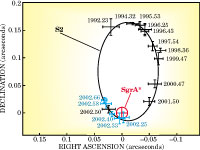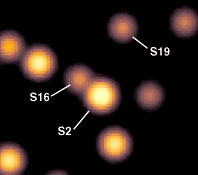| Search and Discovery | ||||||||
|
Orbital periods as short as 15 years clinch the case for a supermassive black hole at the Galaxy's heart. Sitting 25 thousand light-years from the great mass concentration at the core of the Milky Way, the Solar System takes 230 million years to complete an orbit about the Galactic center. The prevailing opinion among astrophysicists is that a supermassive black hole, some 3 million times heavier than the Sun, lurks at the heart of this mass concentration about which the Galaxy wheels.In recent months, two groups of observers have spectacularly strengthened that presumption by watchinmg several stars pass within light-hours of the Galactic center and orbit it with periods as short as 15 years. Such fast and tight orbits imply a central mass concentration far denser than any cluster of stars could account for. These observations, accomplished with adaptive optics and speckle imaging at large telescopes in Chile and Hawaii, are tours de force of infrared astronomy. At visible wavelengths, stars near the Galactic center are totally obscured from our view by intervening dust. But at 2 mm in the near infrared, roughly 1 stellar photon in 10 makes it all the way through the Galactic dust. Still, without some means of combating atmospheric blurring, even the biggest ground-based telescopes, under the clearest skies, cannot possibly resolve individual stars well enough to chart their orbits in the very crowded field surrounding the center of the Milky Way.
The fastest orbiter
For more than a year now, a group led by Reinhard Genzel (Max Planck Institute for Extraterrestrial Physics, Garching, Germany) has been availing itself of the adaptive-optics system at an 8-meter telescope of the European Southern Observatory's Very Large Telescope (VLT) complex in Chile to observe the innermost neighborhood of the Galaxy. Last spring, the Garching group had the good fortune of observing the very eccentric orbit of a star (labeled S2) as it was rounding the Galactic center at a speed in excess of 5000 km/s, with a closest approach (its "pericenter") of only 17 light-hours.1 (By comparison, Earth orbits the Sun, 8 light-minutes away, at a leisurely speed of 30 km/s.)
The precise position of the center about which the Milky Way revolves has, since the 1970s, been identified with the compact radio source Sagittarius A*. In the early 1980s, Charles Townes and coworkers at the University of California, Berkeley, used infrared Doppler spectroscopy to show that gas clouds near Sgr A* seemed to be orbiting a prodigious mass concentration. At the time, Genzel was a postdoc in Townes's group. Since then, the accumulated evidence of rapidly varying x-ray emission from Sgr A* and the motion of stars as well as gas clouds in its extended vicinity, has provided a strong case that the Galactic center is a supermassive black hole. But before the Garching team's recent determination of S2's orbit, the evidence could not conclusively rule out alternatives to a central black hole. Conceivable alternatives included, for example, a very dense cluster of dark stellar objects or even a degenerate ball of heavy neutrinos or other conjectural fermion species, packed together at the maximum density allowed by the Pauli exclusion principle. Now, however, the very close approach of S2 to the Galactic center, and its Keplerian orbit, has foreclosed any credible alternative to a black hole with a mass of at least 2 ´ 106 solar masses. So massive a collection of dark stars, neutron stars, and stellar black holes might conceivably, abeit implausibly, be crowded into a core of radius 10 light-days--the closest approach of S2 previously reported. But a star cluster of that mass crowded into a ball of radius 17 light-hours must quickly either dissipate or collapse into a supermassive black hole. Many galaxies exhibit x-ray or radio evidence of central black holes with masses on the order of 106 solar masses (see Physics Today, December 2002, page 16). But such supermassive black holes, unlike stellar black holes, are not required by astrophysical theory. In any case, the confirmed existence of a supermassive black hole so close to us should prove to be an observational boon. It could teach us much about how galaxies form. And the ability to study stellar orbits in its immediate vicinity promises to provide stringent new tests of general relativity. The other team scrutinizing stars rapidly orbiting the Galactic center is headed by Andrea Ghez at UCLA. That group has been monitoring stars near Sgr A* at the 10-meter Keck telescope in Hawaii since 1995 by speckle imaging and, since 1999, also by adaptive optics. In 2000, the UCLA group reported the first clear evidence of curvature in S2's path across the sky.2
Telltale lines
Recently, the UCLA group has been using the Keck telescope's adaptive-optics system to make infrared spectral-line measurements of S2. The spectral lines provide two important pieces of information about S2: its spectral class and its Doppler shift.3 The Doppler shift, giving the star's velocity component along the line of sight, has tightened the orbital parameters deduced by the Garching group, and has resolved the sign ambiguity in the orbit plane's tilt angle that remains when one only knows the orbit's projection on the celestial sphere. Settling the ambiguity tells us that S2 is, in fact, revolving about Sgr A* in the opposite sense from the general rotation of the Milky Way. More provocative is what the spectral class tells us about the star itself. The UCLA group deduces from the observed hydrogen and helium absorption lines that S2 is quite massive (about 15 solar masses) and younger than 10 million years. This surprisingly tender age poses a puzzle for the theory of star formation. The star is undoubtedly much younger than the supermassive black hole so ominously close by. Even at a separation of ten light-days--S2's furthest distance from the center--an extended protostellar cloud would presumably have been so severely disrupted by the black hole's tidal force as to preclude normal star formation. Because tidal force is proportional to the size of the stressed object, tidal disruption ceases to be a threat once a star is already formed by the contraction of its much larger protostellar cloud, even when the star comes within 17 light-hours of the central black hole. In fact, the UCLA group has recently reported the discovery of another star, labeled S16, whose extremely eccentric orbit brings it, once every 45 years, to within 8 light-hours of the Galactic center. That's not much farther than Pluto's distance from the Sun. S16 appears to be about as young as S2. At wavelength l, the diffraction limit on the angular resolution of a telescope of aperture diameter D is roughly l / D radians. At 2 mm in the infrared, a ten-meter telescope could, in the absence of atmospheric turbulence, have a resolution of 50 milliarcseconds. The atmosphere, in effect, breaks up the coherent wavefront of a pointlike stellar image into patches of approximately uniform phase. At near-infrared wavelengths, these patches are about 1 m wide, yielding, at best, a resolution of only 0.5 arcsec. That's much too coarse for the purposes of the teams monitoring the month-by-month movements of stars in the innermost 2 ´ 2 arcseconds of the Galaxy.
Fighting atmospheric blurring
Until last year, the Garching and UCLA groups were relying largely on speckle imaging to combat atmospheric turbulence. Essentially, one freezes the turbulence by imaging a star with a sequence of many brief exposures, each short enough (about 0.1 s) to minimize the blurring of the image by the incessant wrinkling of the wavefront. Each short exposure produces a random interferometric pattern of multiple, faint diffraction-limited images (speckles) of every star in the field. One then combines several hundred such exposures by superposing, from each, the brightest speckle of a prominent star in the image field. For stars as bright as S2, this simple superposition is enough to produce a reasonable approximation of a diffraction-limited image. Imaging much fainter stars, in search of one that might come even closer to the center than S16, requires arduous Fourier transformation of the speckle images--or better still, the use of adaptive optics. However, for spectroscopy on even the brightest stars near the Galactic center, adaptive optics is indispensable. An adaptive-optics system of the kind now mounted on the VLT and Keck telescopes uses an array of several hundred actuators poking at the back of a flexible auxiliary mirror in the telescope's optical system. In response to computer commands every few hundredths of a second, the actuators locally deform the mirror by a fraction of a micron, to compensate for the distorted wavefront arriving at the telescope (see the article by Laird Thompson, Physics Today, December 1994, page 24). The commands to the actuators are computed in real time from the momentary atmospheric distortion of a bright guide star in the telescope's field, as imaged through a mosaic lens onto a CCD array. The individual components of the mosaic lens produce images of different segments of the arriving wavefront. In place of guide stars, the VLT and Keck adaptive-optics systems will soon be routinely using artificial stars--laser spots focused high up in the atmosphere.
Of course, a supermassive black hole is not simply a point mass. The Schwarzschild radius of a 3 million solar masses black hole, which defines its event horizon, is about half a light-minute. That's only 0.05% of S2's distance of closest approach. So the event horizon has no gross effect on the star's orbit. But it might engender some subtle, unanticipated gravitational effect. The Garching group's best fit to the S2 orbital data alone yields a value (3.7 ± 1.5) ´ 106 solar masses for the mass of the central black hole. The UCLA group derives a mass of (3.0 ± 0.5) ´ 106 solar masses by fitting the observed orbit segments of eight Galactic-center stars it has been following.4 One can constrain the mass still more tightly by including the extensive existing body of statistical data for the myriad stars and gas clouds all the way out to 30 light-years from Sgr A*. In that way, the Garching group arrives at a mass of (2.6 ± 0.2) ´ 106 solar masses for the black hole at the center of the Milky Way. "There's more to come," says Genzel. "With the advent of infrared interferometry using paired telescopes at the VLT and at the Keck observatory, we should have 10 times better angular resolution five years from now. Then we'll really be able to study, up close, the fantastic supermassive black-hole environment that presumably sits at the center of almost every galaxy."
Bertram Schwarzschild
1. R. Schödel et al., Nature 419, 694 (2002).
2. A. M. Ghez et al., Nature 407, 349 (2000).
3. A. M. Ghez et al., Astrophys. J. Lett. (in press).
© 2003 American Institute of Physics
|
|
|
||||||
|
||||||||

